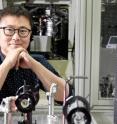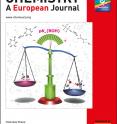Capturing the acid-base reactions in alcohol
A new research, affiliated with UNIST has been featured as a 'Hot Article' on the front cover of the March issue of Chemistry: A European Journal. This study has been regarded as "very important" because it offers a new framework for understanding reactions in organic chemistry. The team, made up of five Korean scientists and experts from the IBS Center for Soft and Living Matter, the Korea Advanced Institute of Science and Technology (KAIST), and Ulsan National Institute of Science and Technology (UNIST), reported the basicity enhancement of an alcohol by hydrogen-bonded clustering.
In their study, the team addressed the cooperative role of alcohols, the simplest organic protic compounds, in one of elementary reactions in chemistry, the acid-base reaction, in a quantitative manner.
According to Prof. Oh-Hoon Kwon (Department of Chemistry, UNIST), the corresponding author of this study, "The motivation of this work, in particular, was the observation that the photoinduced proton transfer can also occur in alcohol with a properly chosen photoacid."
The formation of an alkyl oxonium ion has long been proposed as a key reaction intermediate in alcohol dehydration. This was examined by time-resolved fluorescence quenching of a strong photoacid in their study.
Through their analysis, the research team revealed, for the first time, that the collaboration of two alcohol molecules through hydrogen bonding is critical to enhancing their reactivity and promotes the resulting alcohol cluster to form an effective Brønsted base when reacting with an acid as strong as sulfuric acid.
Prof. Kwon states, "This finding addresses, as in water, the cooperative role of protic solvent molecules to facilitate nonaqueous acid-base reactions." He continues, "However, further systematic investigation on the size variation of clusters formed from diverse alcohols of different basicity and photoacids of different acidity is currently underway."
Source: Ulsan National Institute of Science and Technology(UNIST)
Other sources
- Capturing the Acid-base Reactions in Alcoholfrom Science Daily9 years ago
- Capturing the acid-base reactions in alcoholfrom Science Daily9 years ago
- Capturing the acid-base reactions in alcoholfrom Physorg9 years ago



